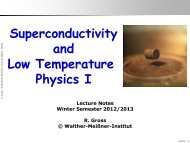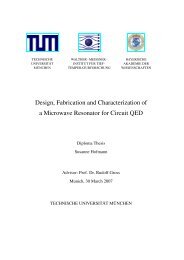Applied Superconductivity - Walther Meißner Institut - Bayerische ...
Applied Superconductivity - Walther Meißner Institut - Bayerische ...
Applied Superconductivity - Walther Meißner Institut - Bayerische ...
- No tags were found...
Create successful ePaper yourself
Turn your PDF publications into a flip-book with our unique Google optimized e-Paper software.
164 R. GROSS AND A. MARX Chapter 4We still have to discuss the dependence of the supercurrent on the applied magnetic flux. From (4.1.20)we obtain for large β LI cir ≃ − Φ ext − nΦ 0L. (4.1.25)We see that I cir → 0 for large L. Then, the applied current divides about equally in the two SQUIDarms. The maximum current is obtained to Ism ≃ 2I c . When n is initially zero, a small screening currentI cir ≃ −Φ ext /L will flow to screen the applied magnetic field. Therefore, the current I 1 will tend todecrease and I 2 to increase with increasing Φ ext . However, since I 2 ≤ I c , it will be fixed at I c as I 1decreases asI 1 ≃ I c − 2Φ extL. (4.1.26)With this expression for I 1 and I 2 ≃ const ≃ I c we obtainIs m ≃ 2I c − 2Φ extor (4.1.27)LIsm ≃ 1 − 2Φ ext 1. (4.1.28)2I c Φ 0 β LWe see that the modulation of the maximum supercurrent of the SQUID by the applied magnetic flux isstrongly decreasing with increasing β L roughly proportional to 1/β L .4.1.2 The Voltage StatePractical dc-SQUIDs are not operated in the zero voltage state. They are operated at a constant biascurrent above the maximum supercurrent I m s (0) at zero applied magnetic flux. That is, the SQUID is inthe voltage state. We will show that in this situation the dc-SQUID produces an output voltage that isrelated to the applied magnetic flux.Negligible screening: β L ≪ 1, strong damping: β C ≪ 1In order to discuss the dependence of the SQUID voltage on the applied magnetic flux we start with thelimit of negligible screening. In this case the total flux in the SQUID loop is just given by the appliedflux. We further assume that the junction capacitance is negligible small, that is, we consider the case ofstrongly overdamped Josephson junctions (β C ≪ 1) and that the two junctions are identical. Then, weonly have to consider the Josephson current and the resistive current givingI = I c sinϕ 1 + I c sinϕ 2 + V + V R N R N= 2I c cos(π Φ )sin(ϕ 1 + π Φ )+ 2 V . (4.1.29)Φ 0 Φ 0 R NHere, we have used (4.1.1) and (4.1.8). Let us define the new phaseϕ = ϕ 1 + π Φ Φ 0(4.1.30)© <strong>Walther</strong>-Meißner-<strong>Institut</strong>
















